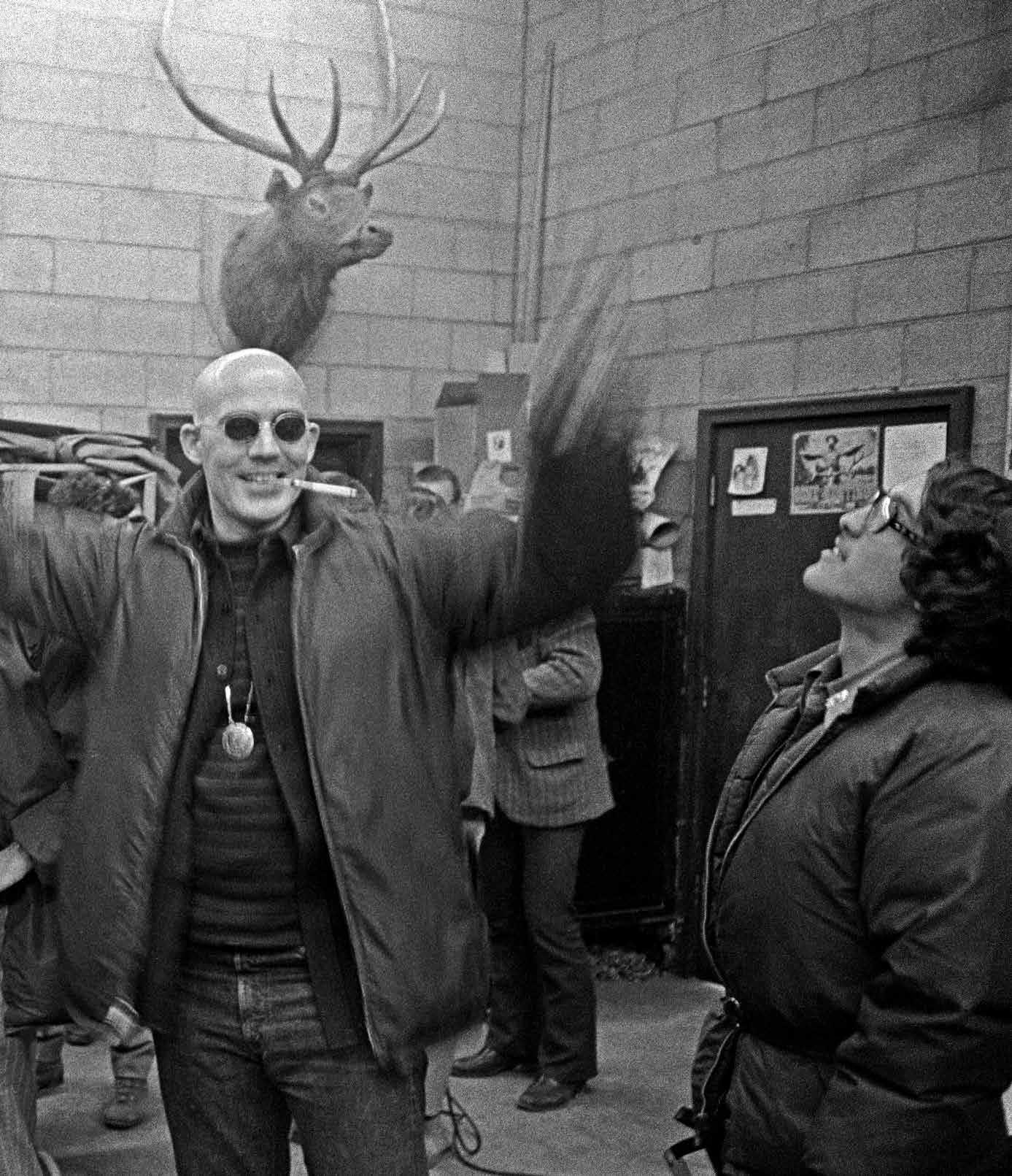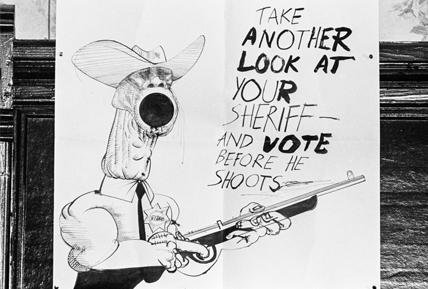
9 minute read
Freak Power - H.S. Thompson's Bid for Sheriff
– Hunter S. Thompson, 1970
Advertisement

Hollywood has portrayed Hunter S. Thompson as an erratic Gonzo, caught in a hurricane of guns, drugs - and always - Fear and Loathing in Las Vegas. But there’s another story to tell. And this one, which surfaces a whole different Thompson - comes to life through the eyes of Daniel Joseph Watkins’ documentary, Freak Power - The Ballot or the Bomb.
The story begins in 1970, when Thompson - a writer and journalist - kicks off a campaign to run for Sheriff of Pitkin County, Colorado. Pitkin has a population of under 20,000 and the city of Aspen is the seat of local government. With the popular history of Thompson’s tales now accessible for all, the mere idea of him running for sheriff may seem odd. But you have to look beyond Aspen and Pitkin County: the U.S. was in tough times in the 60’s and 70’s as revolution fueled by the desire for change, and the rise of “hippies” was reshaping the landscape of America. And really, it was the combination of local, national, and international happenings of the time that brought forth the movement known as Freak Power, led by none other than Hunter S. Thompson.
The societal and cultural elements of the 60’s and 70’s were, in a sense, a form of rebirth for America, fed by the Vietnam War, racism, sexism, and police militancy. And for Thompson, part of the issue was a local rush of developers taking over Aspen Valley, in essence early environmental advocacy. In Aspen and many cities around the country, an old guard was established and resistant to change. But the hippies were moving in with entirely different perspectives on happiness, politics, the environment, and what makes life worth living.
It boiled down to a societal split, groups that could not see eye-toeye. The similarities to our current landscape are uncanny.
If you haven’t seen the film, go stream Freak Power now, because it is amazing. But know that if you’re looking for a Fear and Loathingstyle Gonzo show, Freak Power just ain’t it. The story and film open doors to historical context that reach well beyond the history books, and presents an intelligence and contemporary relevance through the power of art and of local people to make change happen in their communities on up to the national and global levels - and the power to build a movement on ideals, perseverance and art.
We had the opportunity to speak with DJ Watkins, the producer of Freak Power and curator of Aspen’s Gonzo Gallery. While he was up to his brows in errands - orchestrating the shipment of some Freak Power Art to NYC - he proved to be gracious, articulate, and an outright standup guy.
This is the deep dive into the story behind Hunter S. Thompson and his historical political campaign, through the eyes of a modern revolutionary.


Tell us how the project got started, and did you set off with a specific vision in mind?
DJ: “We knew from writing the book Freak Power that there was a great story, and once we found the footage the story took on a life of its own. One of the exciting things about the project was that as we were making this film about democracy falling apart, voter intimidation, or any exciting political campaign, things started in real life around America. That really made us realize what was happening back in Thompson’s era was happening today.
“Many will say history has a way of repeating itself, but I like to say history doesn’t repeat itself, it rhymes.”
When George Floyd was killed, there was a resurgence of Black Lives Matter, police oppression, police brutality, and there was this whole new conversation. What is compassionate law enforcement and community policing? Those were really important ideas that Hunter was espousing 50 years ago. Another exciting thing about making the film was that it seemed the story became more relevant and timely. And that had a lot do with why we released Freak Power when we did. Hunter’s story is about a small town political race, but the story of Freak Power has national relevance and implications. The film really speaks to where we are today.”
On the parallels of the Freak Power Movement and the current social and political environment - does that concern you, or give you hope?
DJ: “Both. It’s uplifting and hopeful to know that we’ve been through shit-shows before. In 1970 there were 4,000 bombings in America. So it’s sad because we haven’t come so far as a country, the divisions are still there. But it also shows that we can get through it - that’s one of the uplifting parts of the story. And what Hunter was fighting for, which is really important to think about right now, was about the rise of interesting, young, inspiring political leaders. We need those people.”
The vision that many people have of Thompson are largely based on Fear and Loathing. Freak Power presents a starkly different person, a deeply intellectual, charismatic, natural leader. Were you surprised by the footage?
DJ: “We had some battles over the film. Some people wanted to see the crazy Hunter. But our archival elements just didn’t speak to that side of him. Sure, there were a couple exciting, weird, Gonzo things in our footage. But as a whole, it was serious, thoughtful, charismatic. I think Hunter deserves more credit for being one of the greatest journalists of the 20th century, creating his own form of journalism, and for his courage to stand up for what he believed in. Those are powerful things. You wouldn’t necessarily want to go up against the police structure, but Hunter went right at it.
He was also one of the first to espouse environmentalism. He had an environmental task force to find people who were abusing the environment. He talked about pollution. He talked about development. He talked about protecting our ecosystem. And I wish other people had seized on that aspect of Hunter.

And it’s humorous, but his plan to change Aspen’s name to Fat City was really about calling out development, which was a big issue in his campaign. Aspen was getting run over by developers at that time. The campaign wasn’t so much about Hunter himself, but in creating a roadmap for other people to make political change. These same issues are happening all over the place - Park City, Venice Beach - you name it.”
Hunter’s writing and the art by Ralph Steadman and Tom Benton were powerful parts of the Freak Power movement. Do you think the written word and artwork are still as powerful in social movements today?
DJ: “I think art is really important in creating movements and making politics exciting. In my book about Tom Benton, artist Paul Pascarella said, “Tom Benton’s art made it really easy for everyone to understand who’s on whose side.” You immediately knew who you were going to vote for.
The 1972 George Mcgovern Presidential Campaign was a real watershed in political art. I do think that art is lacking today, and one of the cool things about the book and Benton’s art is how his work speaks to today. There is a renewed meaning in the posters, and two come to mind, “Celebrate Man’s Inhumanity to Man” and “Patriotism is the Last Refuge of a Scoundrel.” I think we should look back to Benton’s art to be inspired to make new art. Political art and artwork in general is critical to any social movement, and I think clever politicians should use it and that it’s wise to look at Hunter and Benton as a template on how to make a political campaign savvy, interesting and fun.”
What do you want people to take away from Freak Power; what do you want them to do?
DJ: “Hunter’s campaign shows that people can have a profound impact on their community by running for office, voting, and getting involved. And although Hunter didn’t win the race for sheriff, he registered 1000 Freaks to vote. Those same people elected progressive minded people in 1972; those people instituted the open space and trails program, they helped start affordable housing, helped preserve the environment, helped limit development. Many of the things we love about Aspen today go back to what Hunter and his friends took a stand for.”
How did you even get aligned with Hunter, and what led you to open the Gonzo Gallery, start the book, and how was the footage found for Freak Power?
DJ: “My introduction was through the artwork of Tom Benton, that was my first book - looking at political art from the 60s and 70s and how its message can be reinterpreted today. Benton’s artwork was my intro to Thompson.
The footage was a twist of fate. One evening at the Woody Creek Tavern my buddy Bob Brautis, (former Aspen sheriff of 24 years), introduced me to his goddaughter who controlled the footage. Brautis basically said, “This is my friend DJ, he wrote the book, he knows the story, you’ve got to work with him.”
So we found the initial can in a barn in Aspen and that led us to LA to look at another archive. These were all disparate elements - audio and video files, and nothing was synced. It was a year’s effort to try to sync things together before we found a scene with a sawed off shotgun that matched up with audio, which we were transcribing. And we were all like, “holy shit!” Finally we were able to piece the files together and come up with 13 minutes of continuous footage. I have to give credit to the Historical Society and all the local footage they provided. And to Tim’s TV, a British TV crew that had filmed a 25-minute documentary. And Hiser’s photos, Prager’s photos, Benton’s posters; my work on the Benton book gave us access to much of what we needed.
And as our time with DJ concluded, his simplistic take on the whole experience of the project is probably something even Hunter S. Thompson would be comfortable articulating. Watkins finished by saying, “The film itself was kind of an “aha” moment.”
Freak Power: The Ballot or the Bomb is available to stream on iTunes, Google Play, Amazon, and Vimeo.
freakpower.com
Political posters by activist Thomas W. Benton, gunshot art by journalist Hunter S. Thompson, artwork by the illustrator Ralph Steadman as well as work by leading contemporary artists and photographers are on display at the Fat City Gallery in downtown Aspen.










